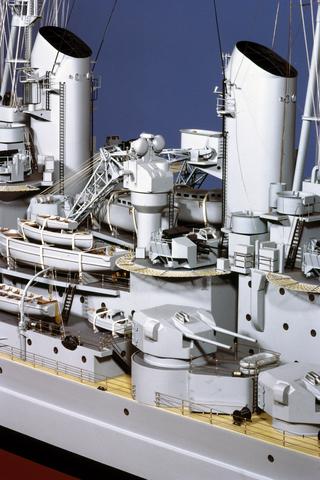
Whole Model H.M.S. "Belleisle" and "Orion"
Whole Model H.M.S. "Belleisle" and "Orion", built at Poplar 1876 to 1879. In glass case. Bellisle is a model scale of 1/48.
The Belleisle illustrates not only the advances which had been made in warship design by the 1870s but also many of the shortcomings which resulted from a general failure to decide between the many conflicting opinions as to the most effective basic design for battleships.
In 1878 there was a possibility of Britain being drawn into conflict with Russia following the Russo-Turkish War. It was realised at this time that the British fleet, consisting of a heterogeneous assortment of vessels, was inadequate for major operations. This international tension was also responsible for the purchase by Britain of four ironclads - the Bellisle, Orion and Superb, then under completion for the Turkish Navy, and the Neptune, then in hand for Brazil. Heavy expenditure was required to convert them to British standards in armament, construction and equipment. Designed in Constantinople for service in the Black Sea and Mediterranean, the Belleisle was built by Samuda Brothers at Poplar. At that time, private British yards were kept busy with orders from abroad for ships which could always be regarded as potential reserves for the Royal Navy, even though the ships might differ broadly from British practice.
The Bellisle, a central battery ironclad, in some ways symbolised the transition from the broadside to the revolting turret system of armament disposition. She was however primarily designed as a ram, with gun power as a secondary weapon. She made no pretence of being an ocean-going vessel and her low speed and limited coal capacity made her quite unsuitable for fleet or blockade work. She was initially listed as an armour-plated ram, later elevated to the rank of second-class battleship and finally received proper recognition as a coast defence ship.
Still rigged for sail, she was converted to take four 25-ton rifled muzzle-loaders and extra bunkers, while her long ram was stiffened. The four 25-ton guns were disposed at the corners of an octagonal battery situated on the upper deck amidships. The ports were enlarged to allow the guns to be trained through 120 degrees, permitting a concentration of two guns directly ahead of astern and two over a limited area on the beam. She was protected by an armoured belt on the waterline, 10ft, deep and 12 inches thick amidships with 7 inches at the bow. The central battery carried 10 1/2 inch plating on the sides and 9 1/2 inch over the end bulkheads.
Although the distribution of the gun power was excellent when employed as a support ram, it offered no advantages for use in line-of-battle. The Belleisle and Orion were therefore the last British ships to carry their guns in a central battery, the only British ships to have their entire armament in an upper-deck central battery and the only British ships to carry 12-inch guns on the broadside.




